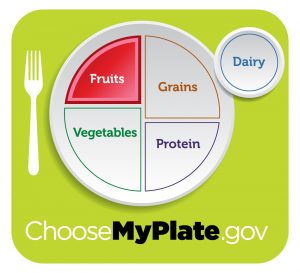Bulletin #4391, Eating for Health with MyPlate: Fruits
Prepared by Extension Educator Kate Yerxa and Extension Specialist Leslie Forstadt, University of Maine Cooperative Extension. Reviewed by Extension Educators Alan Majka and Jane Conroy, University of Maine Cooperative Extension.
For information about UMaine Extension programs and resources, visit extension.umaine.edu.
Find more of our publications and books at extension.umaine.edu/publications/.
Like most Americans, Mainers eat too much fat, sugar, sodium, and refined grains. These Eating for Health with MyPlate fact sheets can start you down the path to good health. Each one is about a different part of the 2020-2025 Dietary Guidelines for Americans and MyPlate healthy eating guidelines. You can learn what each part is, why it’s important, and how it matters to you and to your family. The MyPlate food groups are Grains, Vegetables, Fruits, Dairy, and Protein. This fact sheet explains the Dairy Group.
Which foods are in the Fruit Group?
Any fruits are part of the Fruit Group. So is 100% fruit juice. Fruits can be fresh, frozen, canned, or dried. They can be whole, cut up, or pureed. Fruits include foods like apples, oranges, bananas, peaches, blueberries, strawberries, grapes, and melon.
How much of this food group should adults eat?
The amount of fruit needed each day is different for everyone. The average adult needs about 2,000 calories a day. In a 2,000 calorie diet, you need 2 cups of fruit a day. One cup of fruit is equal to
- 1 small apple (the size of a tennis ball)
- 1/2 cup of dried fruit
- 1 cup of cut-up fruit
- 1 large banana (8 inches long)
- 1 cup of 100% juice (go easy on juice—it’s high in calories and not a filling as fruit.)
Why fruits?
Eating a healthy diet high in fruits may reduce the risk of some diseases, like diabetes and heart disease. Fruits are generally low in calories and fat. And they taste great! Enjoy many different colors of fruits.
Fabulous ways to eat more fruits
- Add dried fruit to breakfast cereal.
- Pack canned fruit with lunch.
- Grab a piece of fruit for a snack on the go.
- Have a glass of 100% juice.
Kids and fruit
Fruits are wonderful desserts and snacks. Children can help pick out and prepare fruits.
- At the store, do a color search. Find fruits that are green, yellow, red, and orange. See if you can find purple ones.
- Try a new fruit. Search for fruits your children have not eaten before. Some fruits to try include starfruit, UGLI® fruit, or white-fleshed peaches.
- Choose three fruits at the store to make into a fruit salad. If you use apples, pick a citrus fruit to go with them, like orange or grapefruit. The citrus juice will keep the apples from turning brown.Your child can pick three different colors of crayon or marker and draw the fruit. Using colors that are different than the fruit makes a wild drawing!
- Bring snacks of real fruit, like apples or bananas, if you’re going out for the day. Pack a snack or lunch for your child. Include a fruit of their choice.
- You can help your child learn where fruits come from. Visit an apple orchard, a strawberry farm, or a blueberry field when the fruit is in season.
How to build a healthy plate
Balance calories
- Enjoy your food, but eat less.
- Avoid oversized portions.
Eat more of . . .
- Make half your plate fruits and vegetables.
- Make half your grains whole.
- Switch to fat-free or low-fat (1%) milk.
Eat less of . . .
- Compare sodium in foods like soup, bread, and frozen meals. Choose the foods with lower numbers.
- Drink water instead of sugary drinks.
Sources
U.S. Department of Agriculture and U.S. Department of Health and Human Services. Dietary Guidelines for Americans, 2020-2025. 9th Edition. December 2020. Available at DietaryGuidelines.gov.
U.S. Department of Agriculture. MyPlate website. 2021. https://www.myplate.gov

Information in this publication is provided purely for educational purposes. No responsibility is assumed for any problems associated with the use of products or services mentioned. No endorsement of products or companies is intended, nor is criticism of unnamed products or companies implied.
© 2011, 2017, 2021
Call 800.287.0274 (in Maine), or 207.581.3188, for information on publications and program offerings from University of Maine Cooperative Extension, or visit extension.umaine.edu.
In complying with the letter and spirit of applicable laws and pursuing its own goals of diversity, the University of Maine System does not discriminate on the grounds of race, color, religion, sex, sexual orientation, transgender status, gender, gender identity or expression, ethnicity, national origin, citizenship status, familial status, ancestry, age, disability physical or mental, genetic information, or veterans or military status in employment, education, and all other programs and activities. The University provides reasonable accommodations to qualified individuals with disabilities upon request. The following person has been designated to handle inquiries regarding non-discrimination policies: Director of Equal Opportunity and Title IX Services, 5713 Chadbourne Hall, Room 412, University of Maine, Orono, ME 04469-5713, 207.581.1226, TTY 711 (Maine Relay System).


